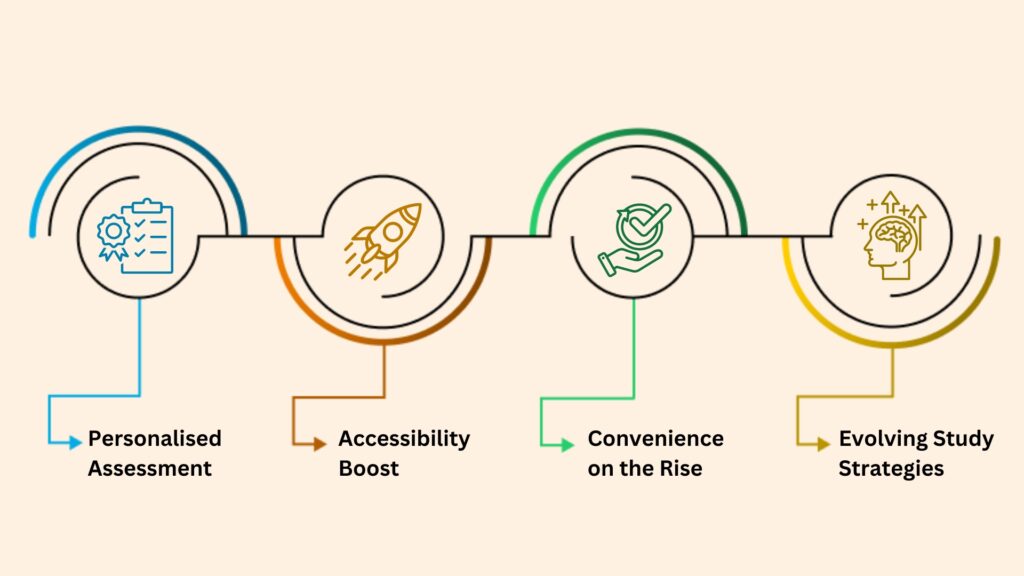For millions of students worldwide, the SAT is a stepping stone to prestigious colleges. But have you ever typed “SAT” into a search engine and felt instantly lost in a sea of information? This comprehensive guide is here to be your life raft, answering all your questions about the SAT exam pattern.
First things first – gone are the days of bulky booklets and bubble sheets! Recently, the SAT transitioned to a fully digital format (dSAT), making it more accessible and streamlined for test-takers everywhere. This innovative approach utilises adaptive testing, tailoring the difficulty of questions to your performance.
So, what does the digital SAT exam pattern look like? It’s divided into two main sections:
- Evidence-Based Reading and Writing (EBRW): This section combines reading comprehension, analysis, and writing skills.
- Maths: Here, you’ll showcase your problem-solving abilities in core mathematical areas like algebra, data analysis, and functions.
Both sections have two modules, each with its own set of questions.
Now that you have a basic understanding of the SAT exam pattern, this guide will delve deeper into each section, SAT exam format, and SAT exam question pattern.
Stay tuned – your college dreams are just a well-prepped SAT away!
Key Highlights of SAT Exam Pattern
Here are the key highlights to give you a clear and concise overview of the SAT exam pattern.
| Feature | Details |
| SAT Exam Duration | 2 hours and 14 minutes |
| Number of Questions | 98 |
| Sections | Evidence-Based Reading and Writing (EBRW) Maths |
| Score Range | 4,00-1,600 |
| Top Universities Using SAT | Harvard University (QS World Rank 2025: 4) Stanford University (QS World Rank 2025: 6) MIT (QS World Rank 2025: 1) |
| Language | English |
| Does SAT have Negative Marking | No |
SAT Paper Pattern
The SAT paper pattern has evolved, with the latest digital format bringing significant changes in 2024. The exam now consists of two main sections: Evidence-Based Reading and Writing (ERW) and Maths, each designed to test specific skills.
The EBRW section includes reading comprehension and grammar questions, while the Maths section covers algebra, problem-solving, and data analysis. The total duration of the SAT exam is 2 hours and 14 minutes, without an essay. The digital format has streamlined the test-taking experience, providing a user-friendly interface and quicker score reporting.
Let’s have a closer look at the table below to understand the SAT paper pattern carefully.
| Feature | Reading & Writing (EBRW) | Maths |
| Modules | 2 | 2 |
| Questions per Module | 25 | 20 |
| Total Questions | 54 | 44 |
| Time per Module | 32 minutes | 35 minutes |
| Total Time Allotted | 1 hour 4 minutes (64 minutes) | 1 hour 10 minutes (70 minutes) |
| Question Types | Multiple-choice Reading Comprehension Writing prompts | Multiple-choice Short answer Writing prompts |
| Topics Covered | Reading Passages (Literature, Science, Social Science) Writing (Analysis, Argument, Narrative) | Algebra Data Analysis Statistics Probability Functions |
Also read: SAT Exam Syllabus & Pattern 2024
SAT Exam Pattern for EBRW Section
The SAT isn’t just about number crunching; it also assesses your skills in critical thinking and communication. The Evidence-Based Reading and Writing (EBRW) section is your chance to showcase your ability to analyse complex texts and express yourself clearly.
This section consists of two modules, and you’ll have a total of 64 minutes to demonstrate your reading comprehension, analysis, and writing skills.
Let’s look at the below table carefully to understand the EBRW section.
| Subject Area | Knowledge Testing Points/Syllabus | Question Distribution |
| Craft and Structure | Context Text structure Cross-text connections | 13-15 questions |
| Information and Ideas | Central ideas Evidence Inferences | 12-14 questions |
| Standard English Conventions | Grammar Structure Clarity | 11-15 questions |
| Expression of Ideas | Rhetorical synthesis Transitions | 8-12 questions |
SAT Exam Pattern Outline for Maths
The Mathematics section of the SAT exam is a critical component that tests your quantitative reasoning and problem-solving abilities. With a redesigned digital format, the sat exam pattern for Mathematics aims to provide a comprehensive and adaptive assessment tailored to your specific skill level.
The mathematics section of the SAT exam syllabus focuses on algebra, advanced maths, problem-solving, data analysis, geometry, and trigonometry. It is divided into two modules, each containing 20 scored questions.
| Subject Area | Knowledge Testing Points/Syllabus | Question Distribution |
| Algebra | Linear equations Inequalities Functions | 13-15 |
| Geometry & Trigonometry | Area Volume Angles Triangles Circles | 5-7 |
| Advanced Maths | Nonlinear equations Functions | 13-15 |
| Problem-solving & Data Analysis | Ratios Percentages Probability Statistics | 5-7 |
*Remember: The SAT exam question pattern focuses on assessing your foundational skills, not memorisation. By understanding the format and practising each section, you’ll be well on your way to SAT success!
SAT Exam Question Pattern 2024: A Section-Wise Breakdown
This guide will break down the SAT exam question pattern section by section, empowering you to approach the test with confidence. Here’s a deep dive into each section
Evidence-Based Reading (EBR)
The Evidence-Based Reading (EBRW) section is designed to assess your ability to comprehend and analyse complex reading passages. It measures your critical thinking skills and your capacity to draw inferences and identify key ideas from a variety of sources.
- Focus: Reading comprehension, analysis, and critical thinking.
- Format: Two 30-minute modules, each with 4 passages (25-250 words) followed by multiple-choice questions.
- Question Types:
- Information and Idea Generation: Identifying main ideas and drawing inferences.
- Rhetoric: Analysing the author’s purpose, style, and tone.
- Synthesis: Connecting ideas across passages and interpreting data (graphs, charts).
- Passages: Diverse topics like U.S. founding documents, science, social science, and humanities.
Evidence-Based Writing (EBW)
The Evidence-Based Writing (EBW) section goes beyond basic grammar and mechanics. It evaluates your ability to express ideas clearly and concisely, ensuring your writing is well-structured and free of errors.
- Focus: Writing skills, grammar, and clarity.
- Format: One 50-minute section with one passage and multiple-choice questions.
- Question Types:
- Expression of Ideas: Improving sentence structure, word choice, and overall clarity.
- Standard English Conventions: Identifying and correcting grammar, punctuation, and sentence structure errors.
- Passages: Varied topics like science, humanities, and history
Math
The Math section assesses your problem-solving abilities in core mathematical areas like algebra, data analysis, and functions. It tests your ability to apply mathematical concepts to solve real-world problems and interpret data effectively.
- Focus: Problem-solving skills in algebra, data analysis, and functions.
- Format: Two 35-minute modules with a mix of question difficulty levels.
- Question Types:
- Multiple Choice (75%): Testing core mathematical concepts.
- Student-Produced Response (SPR) (25%): Requiring short answer responses to show work (similar to fill-in-the-blank).
- Calculator Use: Permitted throughout the section (strategic use is recommended).
- Topics:
- Algebra (linear equations, inequalities, functions)
- Problem Solving and Data Analysis (interpreting data, solving real-world problems)
- Passport to Advanced Math (exponents, logarithms)
Also Read: SAT Exam Preparation 2024
Explore all countries
SAT Exam Dates Announcements for 2024
The SAT exam pattern has undergone significant changes, and staying updated on the latest exam dates is crucial. As June arrives, the pressure mounts for those who haven’t yet registered for the coveted SAT test.
Fear not; the College Board has announced specific dates for the digital SAT examination in 2024, ensuring you have ample opportunities to take the test.
If you’ve missed the initial test dates in March, May, and June, there’s no need to panic. The upcoming months offer another chance to register and prepare for the digital SAT before the year draws to a close.
Here’s a rundown of the remaining SAT exam dates for 2024.
- August 24, 2024
- October 5, 2024
- November 2, 2024
- December 7, 2024
*Remember, registration deadlines are typically 4-5 weeks before the test date, so mark your calendars and stay ahead of the curve. By securing your preferred SAT date and test centre well in advance, you’ll have one less thing to worry about as you diligently prepare for this crucial exam.
Why take the SAT exam?
SAT is a standardised test that assesses a student’s readiness for college by evaluating critical reading, writing, and maths skills. The SAT exam pattern, known for its comprehensive approach, helps universities gauge the academic capabilities of applicants consistently.
This is just one of the many reasons why taking the SAT is a valuable step towards your college dreams. Let’s explore some of the other benefits:
- Scholarship Gateway: High SAT scores can unlock doors to merit-based scholarships, easing the financial burden of higher education. Scholarships like the Heinrich Boll Scholarship consider SAT scores as part of their selection criteria.
- Strategic Preparation: Understanding the SAT exam pattern, which includes a mix of multiple-choice and essay questions within a two-hour and 14-minute time frame, is crucial for effective preparation. Familiarity with the format allows you to develop strategies to tackle the exam confidently and achieve your target score.
- Global Accessibility: The SAT is conducted annually in 260 countries, including India with 97 test centres across 27 cities. The digital format further expands accessibility, allowing students to choose between computer-based or paper testing. This flexibility opens doors for international students to pursue higher education in the United States.
The Digital SAT: Impacts on Students

The College Board introduced the digital SAT (dSAT), revolutionising the way you tackle college admissions exams. But how exactly does this shift in SAT exam pattern affect you?
- Personalised Assessment: One of the biggest advantages of the dSAT is its use of adaptive testing. The exam adjusts question difficulty based on your performance, ensuring a more accurate evaluation of your skills.
- Accessibility Boost: The digital format removes geographical and physical barriers. Built-in accessibility features such as zooming, highlighting, and text-to-speech functionality, cater to students with diverse needs, promoting inclusivity. Additionally, the dSAT provides an Desmos calculator (on-screen calculator), eliminating the need for personal devices.
- Convenience on the Rise: The dSAT offers a streamlined experience, allowing you to focus on your skills rather than logistical concerns. Faster score reporting is another bonus of the digital format.
- Evolving Study Strategies: With the transition to digital, SAT study materials and methods need to adapt. You can now utilise digital practice tests that mimic the actual exam environment, including timing, question types, and the digital interface. This allows for targeted preparation and familiarisation with the SAT exam question pattern.
Resources to Prepare for the SAT Exam
Preparing for the SAT exam can be a daunting task, given its comprehensive nature and significant impact on college admissions. With a well-defined SAT exam pattern that includes a variety of question types, it’s crucial to utilise effective resources to maximise your performance.
The College Board, the official body behind the SAT, offers several resources and recommendations specifically designed to help you excel on the exam.
Below are some highly effective resources that can help you navigate the SAT exam pattern and boost your scores.
- Official College Board Materials: The College Board’s website is your ultimate source for official SAT practice tests, SAT exam question patterns, and SAT exam format information. Utilise their free resources like practice questions, sample tests, and the official SAT Study Guide to familiarise yourself with the exam content and structure.
- Khan Academy SAT Practice: This free, personalised study material from Khan Academy offers video tutorials, practice exercises, and full-length practice tests that adapt to your learning pace. Tailored practice helps you identify your strengths and weaknesses, ensuring you focus on areas that need the most improvement.
- Online Forums and Communities: Connect with other SAT test-takers through online forums and communities. Sharing experiences, asking questions, and offering support can be a valuable part of your preparation journey.
- Prep Courses and Tutoring: Many students opt for SAT prep courses or tutoring services to help with the SAT exam format. These structured learning environments often provide focused strategies and practice.
- SAT Prep Books: Comprehensive books from publishers like The Princeton Review and Barron’s provide detailed reviews of all sections of the SAT, including the SAT paper pattern and specific strategies.
How Are SAT Scores Calculated?
The SAT delivers a single, comprehensive score ranging from 400 to 1600. This score combines your performance in two main sections: Evidence-Based Reading and Writing (EBRW) and Math. Each section is independently scored on a scale of 200 to 800.
Here’s a breakdown of how your raw scores (number of correct answers) are transformed into the final SAT score.
- Composite SAT Score: The SAT scores range from 4,00 to 1,600, with separate sections for Evidence-based Reading & Writing and Maths, each scored between 200 and 800.
- Raw Score Conversion: The raw score, the number of correct answers, is converted to a scaled score ranging from 10 to 40. This conversion adjusts for variations in difficulty among different test versions.
- Reading and Writing Score: The raw scores for the Reading Test and the Writing and Language Test are each multiplied by 10. These scaled scores are then summed to determine the Evidence-based Reading and Writing section score.
- Maths Score: The raw score for the Math Test is multiplied by 20 to calculate the scaled Math section score.
- No Penalty for Wrong Answers: SAT does not penalise for incorrect answers, so students should attempt all questions.
Eligibility Criteria for SAT Exam
The beauty of the SAT lies in its accessibility. Unlike some entrance exams, there are no specific academic prerequisites to register for the SAT. As long as you’re aiming for undergraduate studies abroad, particularly in countries like the US, UK, Canada, and Australia, the SAT can be your gateway to prestigious universities.
- The SAT is primarily aimed at high school students, typically taken during the junior or senior year. However, there are no strict age or grade level requirements. As long as you are a current high school student or a prospective college applicant, you are eligible to register for the SAT.
- The SAT does not have any specific educational prerequisites. Whether you attend a public or private high school, are homeschooled, or pursue an alternative educational path, you can take the SAT as long as you meet the grade level criteria.
- To be eligible to take the SAT, you must complete the registration process and pay the applicable fees. Registration typically opens several months before each test date, and students can register online, by mail, or through their high school counsellors.
- On the day of the test, students must present valid and acceptable forms of identification to be admitted to the testing centre. This typically includes a government-issued ID with a photo, such as a driver’s licence, passport, or school ID. Failure to provide proper identification may result in being denied entry to the testing site.
How to Register for the SAT Exam
Taking the SAT is the first step towards achieving your international college dreams. Here’s a breakdown of the registration process.
- Visit the College Board website and create an account. This is essential for registration, accessing scores, and managing your test information.
- Enter your basic details, including your name, date of birth, and contact information.
- Fill in your high school information, extracurricular activities, and preferences regarding college size, type, and majors. This helps colleges learn more about your background and interests.
- Select a suitable test date and a convenient test centre location. Early selection is recommended to secure your preferred choices.
- Ensure you have a recent, clear photograph to upload. This photo will be used for identification purposes on test day.
- At the end, pay the Registration Fee. The registration fee for the SAT is INR 5K, plus a regional fee of INR 3K. Payment can be made online using a credit or debit card.
Tips for Preparing for SAT

Preparing for the SAT exam requires a strategic approach to maximise your scores.
Did you know?
Over 1.7 million students worldwide take the SAT exam every year for their higher studies.
Here are some tips to help you prepare.
Understand the SAT Exam Pattern
- Familiarise yourself with the exam format, question types, and time limits.
- Practice with sample questions to get a feel for the exam.
- Focus on your strengths and weaknesses to optimise your preparation.
Develop a Study Plan
- Create a study schedule and stick to it.
- Set realistic goals and milestones to track your progress.
- Review and practice regularly to build confidence.
Improve Your Reading Comprehension
- Practice reading comprehension passages and questions.
- Focus on identifying the main ideas, supporting details, and the author’s purpose.
- Improve your vocabulary by reading widely and learning new words.
Enhance Your Writing Skills
- Practice writing essays and short answers.
- Focus on clarity, coherence, and grammar.
- Improve your vocabulary and sentence structure.
Master Math Concepts
- Review algebra, geometry, and trigonometry concepts.
- Practice solving problems and equations.
- Focus on applying mathematical concepts to real-world scenarios.
Practice with Sample Questions
- Use official SAT practice tests and sample questions.
- Practice under timed conditions to simulate the actual exam.
- Review and analyse your performance to identify areas for improvement.
By following these tips, you can develop a solid preparation strategy for the SAT exam and achieve your desired scores.
Conclusion
Navigating the SAT exam pattern may initially seem overwhelming, but with the right resources and a thorough understanding of the test format, you can approach it with confidence. The transition to a digital format has modernised the test-taking experience, making it more accessible and efficient. By familiarising yourself with the SAT paper pattern, exam duration, and question types, you’ll be better prepared to tackle the challenges of the exam.
Remember, the SAT does not have negative marking, so take advantage of every opportunity to answer each question. Utilise the numerous resources available, from official practice materials to prep courses, to enhance your preparation strategy. With diligent practice and a clear understanding of the exam structure, you’ll be well on your way to achieving a high score and reaching your college dreams.
Frequently Asked Questions
-
Q. How many questions are there in the SAT exam?
Ans. The SAT exam includes a total of 98 questions, excluding the optional essay. The Evidence-Based Reading and Writing (EBRW) section has 54 questions, while the Maths section has 44 questions. Each section is divided into modules with specific time limits, making it essential for students to practise time management skills to complete all questions within the allotted time.
-
Q. What are the key components of the SAT exam format?
Ans. The SAT exam format includes multiple-choice questions and grid-in responses, particularly in the Maths section. The EBRW section tests reading comprehension and grammar, while the Maths section covers algebra, problem-solving, and data analysis. The optional Essay section evaluates analytical writing skills. Familiarising yourself with this SAT exam pattern helps you understand the types of questions and the best approaches to answer them.
-
Q. What is the SAT exam duration?
Ans. The SAT exam duration is 2 hours and 14 minutes, with an additional 50 minutes if the optional essay is taken. The breakdown includes 64 minutes for the Reading section, the Writing and Language section, and 70 minutes for the Maths section, divided into two parts: one where a calculator is allowed and one where it is not. Efficient time management during the exam is crucial to maximise performance.
-
Q. Does the SAT have negative marking?
Ans. No, the SAT does not have negative marking. This means that there is no penalty for incorrect answers, encouraging students to attempt every question. This strategy can potentially increase your overall score, as guessing does not detract from your total score. Understanding this aspect of the SAT exam pattern can help students approach the test more confidently.
-
Q. How is the SAT scored?
Ans. The SAT is scored on a scale of 400-1600. The EBRW and Math sections each contribute a score between 200 and 800, which are then combined to form the composite score. The optional Essay is scored separately. Raw scores, based on the number of correct answers, are converted to scaled scores to account for variations in test difficulty. Familiarity with the scoring process helps students set realistic score goals.
-
Q. What topics are covered in the Math section of the SAT?
Ans. The Math section of the SAT covers a range of topics, including algebra, geometry, trigonometry, and data analysis. It is divided into two modules: one allowing calculator use and one not. Each module tests problem-solving abilities and the application of mathematical concepts to real-world scenarios. Understanding these topics can help students focus their study efforts on key areas.
-
Q. What is the Evidence-Based Reading and Writing section?
Ans. The Evidence-Based Reading and Writing (EBRW) section assesses reading comprehension, grammar, and writing skills. It includes passages from literature, historical documents, social sciences, and natural sciences, followed by multiple-choice questions. The writing portion tests the ability to identify and correct grammatical errors and improve sentence structure. Understanding the EBRW section is key to excelling in this part of the SAT.
-
Q. How often is the SAT exam conducted?
Ans. The SAT is conducted multiple times a year, typically in March, May, June, August, October, November, and December. Students can choose a test date that best fits their schedule and allows ample time for preparation. It’s important to register early to secure a preferred test date and location.
-
Q. Can international students take the SAT?
Ans. Yes, international students can take the SAT at designated test centres worldwide. The SAT is recognised by universities in many countries, including the U.S., UK, Canada, and Australia. The transition to a digital format has made it more accessible for international students, offering the flexibility to take the exam on a computer or on paper.
-
Q. How can I register for the SAT exam?
Ans. To register for the SAT, visit the College Board website and create an account. Fill in your personal details, high school information, and preferences regarding test dates and locations. Upload a recent photograph and pay the registration fee online (INR 5K). Early registration is recommended to secure your preferred test date and centre.
-
Q. What resources are available for SAT preparation?
Ans. Various resources are available for SAT preparation, including official SAT practice tests, prep books, online courses, and tutoring services. The College Board website offers free practice materials, and there are many third-party resources that provide comprehensive study guides and practice questions. Utilising these resources can help students build a solid preparation strategy.
-
Q. How important is time management during the SAT exam?
Ans. Time management is crucial during the SAT exam due to the strict time limits for each section. Practising with timed tests can help students get accustomed to the pacing of the exam and improve their ability to complete all questions within the allotted time. Effective time management can significantly impact overall performance and scores.

















Have Questions? Get Guidance to reach your Dream University
Connect with India's finest counsellors and biggest study abroad community.
Get Guidance